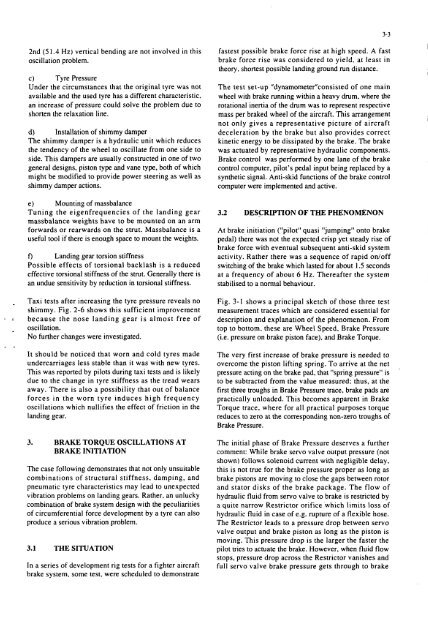AGARD R-800 - FTP Directory Listing - Nato
AGARD R-800 - FTP Directory Listing - Nato
AGARD R-800 - FTP Directory Listing - Nato
You also want an ePaper? Increase the reach of your titles
YUMPU automatically turns print PDFs into web optimized ePapers that Google loves.
- .<br />
- -<br />
2nd (5 1 .d Hz) vertical bending are not involved in this<br />
oscillation problem.<br />
C) Tyre Pressure<br />
Under the circumstances that the original tyre was not<br />
available and the used tyre has a different characteristic,<br />
an increase of pressure could solve the problem due to<br />
shorten the relaxation line.<br />
d) Installation of shimmy damper<br />
The shimmy damper is a hydraulic unit which reduces<br />
the tendency of the wheel to oscillate from one side to<br />
side. This dampers are usually constructed in one of two<br />
general designs, piston type and vane type, both of which<br />
might be modified to provide power steering as well as<br />
shimmy damper actions.<br />
e) Mounting of massbalance<br />
Tuning the eigenfrequencies of the landing gear<br />
massbalance weights have to be mounted on an arm<br />
forwards or rearwards on the strut. Massbalance is a<br />
useful tool if there is enough space to mount the weights.<br />
f) Landing gear torsion stiffness<br />
Possible effects of torsional backlash is a reduced<br />
effective torsional stiffness of the strut. Generally there is<br />
an undue sensitivity by reduction in torsional stiffness.<br />
Taxi tests after increasing the tyre pressure reveals no<br />
shimmy. Fig. 2-6 shows this sufficient improvement<br />
- because the nose landing gear is almost free of<br />
oscillation.<br />
No further changes were investigated.<br />
It should be noticed that worn and cold tyres made<br />
undercarriages less stable than it was with new tyres.<br />
This was reported by pilots during taxi tests and is likely<br />
due to the change in tyre stiffness as the tread wears<br />
away. There is also a possibility that out of balance<br />
forces in the worn tyre induces high frequency<br />
oscillations which nullifies the effect of friction in the<br />
landing gear.<br />
3. BRAKE TORQUE OSCILLATIONS AT<br />
BRAKE INITIATION<br />
The case following demonstrates that not only unsuitable<br />
combinations of structural stiffness, damping, and<br />
pneumatic tyre characteristics may lead to unexpected<br />
vibration problems on landing gears. Rather, an unlucky<br />
combination of brake system design with the peculiarities<br />
of circumferential force development by a tyre can also<br />
produce a serious vibration problem.<br />
3.1 THE SITUATION<br />
In a series of development rig tests for a fighter aircraft<br />
brake system. some test, were scheduled to demonstrate<br />
3-3<br />
fastest possible brake force rise at high speed. A fast<br />
brake force rise was considered to yield. at least in<br />
theory. shortest possible landing ground run distance.<br />
The test set-up "dynamometer"consisted of one main<br />
wheel with brake running within a heavy drum. where the<br />
rotational inertia of the drum was to represent respective<br />
mass per braked wheel of the aircraft. This arrangement<br />
not only gives a representative picture of aircraft<br />
deceleration by the brake but also provides correct<br />
kinetic energy to be dissipated by the brake. The brake<br />
was actuated by representative hydraulic components.<br />
Brake control was performed by one lane of the brake<br />
control computer, pilot's pedal input being replaced by a<br />
synthetic signal. Anti-skid functions of the brake control<br />
computer were implemented and active.<br />
3.2 DESCRIPTION OF THE PHENOMENON<br />
At brake initiation ("pilot" quasi "jumping" onto brake<br />
pedal) there was not the expected crisp yet steady rise of<br />
brake force with eventual subsequent anti-skid system<br />
activity. Rather there was a sequence of rapid on/off<br />
switching of the brake which lasted for about 1.5 seconds<br />
at a frequency of about 6 Hz. Thereafter the system<br />
stabilised to a normal behaviour.<br />
Fig. 3-1 shows a principal sketch of those three test<br />
measurement traces which are considered essential for<br />
description and explanation of the phenomenon. From<br />
top to bottom, these are Wheel Speed. Brake Pressure<br />
(i.e. pressure on brake piston face), and Brake Torque.<br />
The very first increase of brake pressure is needed to<br />
overcome the piston lifting spring. To arrive at the net<br />
pressure acting on the brake pad, that "spring pressure" is<br />
to be subtracted from the value measured: thus, at the<br />
first three troughs in Brake Pressure trace, brake pads are<br />
practically unloaded. This becomes apparent in Brake<br />
Torque trace, where for all practical purposes torque<br />
reduces. to zero at the corresponding non-zero troughs of<br />
Brake Pressure.<br />
The initial phase of Brake Pressure deserves a further<br />
comment: While brake servo valve output pressure (not<br />
shown) follows solenoid current with negligible delay.<br />
this is not true for the brake pressure proper as long as<br />
brake pistons are moving to close the gaps between rotor<br />
and stator disks of the brake package. The flow of<br />
hydraulic fluid from servo valve to brake is restricted by<br />
a quite narrow Restrictor orifice which limits loss of<br />
hydraulic fluid in case of e.g. rupture of a flexible hose.<br />
The Restrictor leads to a pressure drop between servo<br />
valve output and brake piston as long as the piston is<br />
moving. This pressure drop is the larger the faster the<br />
pilot tries to actuate the brake. However, when fluid flow<br />
stops, pressure drop across the Restrictor vanishes and<br />
full servo valve brake pressure gets through to brake

















